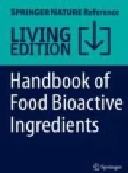Ver ítem
- xmlui.general.dspace_homeCentros e Institutos de InvestigaciónCIA. Centro de Investigaciones de AgroindustriaInstituto de Tecnología de AlimentosPartes de librosxmlui.ArtifactBrowser.ItemViewer.trail
- Inicio
- Centros e Institutos de Investigación
- CIA. Centro de Investigaciones de Agroindustria
- Instituto de Tecnología de Alimentos
- Partes de libros
- Ver ítem
Non-marine Animal Bioactive Peptides. Properties, Sources, and Applications
Resumen
Animal proteins and their derivatives play a fundamental role in human nutrition as a source of valuable nutrients and bioactive peptides that have shown an increased interest for their application in the food, pharmaceutical, medicine, and cosmetics industry. In the past years, animal peptides have increased their application in the pharmaceutical industry, due to their great versatility, varied pharmacological functions, high specificity, and low levels
[ver mas...]
Animal proteins and their derivatives play a fundamental role in human nutrition as a source of valuable nutrients and bioactive peptides that have shown an increased interest for their application in the food, pharmaceutical, medicine, and cosmetics industry. In the past years, animal peptides have increased their application in the pharmaceutical industry, due to their great versatility, varied pharmacological functions, high specificity, and low levels of toxicity as well as being natural compounds with minor or no adverse effects when compared to synthetic drugs. Strikingly, only some of the bioactive peptides are sold on the market as functional foods. The possible reason is that most of them do not have sufficient evidence in terms of efficacy and food safety. Additionally, different processing methods may have a certain impact on their bioavailability, affecting their application in food. Therefore, several encapsulation methodologies are being studied in order to protect bioactive peptides, enhance their bioavailability as well as to enhance their sensory and physicochemical properties. This chapter summarizes current knowledge on peptides from meat, milk, and eggs, the main methods of obtaining peptides (enzymatic hydrolysis with commercial proteases, fermentation, and gastrointestinal digestion) and their bioactive properties (antihypertensive and cardiovascular health improvement, antioxidant, antidiabetic, antiobesity, antitumor activity, gut, and neurological health improvement). Moreover, peptide bioaccessibility and bioavailability studies will also be discussed, since these are key factors for these compounds to exert their mechanisms of action in the body. Finally, a discussion about the food applications and perspective studies for promoting animal bioactive peptides use is carried out. In sum, the full set of reported bioactivities plus future research on the efficacy and safety through clinical studies, coupled with the efficient use of byproducts for a sustainable production of these peptides, will reveal the full scope of potential applications of these natural molecules.
[Cerrar]
Las proteínas animales y sus derivados juegan un papel fundamental en la nutrición humana como fuente de valiosos nutrientes y péptidos bioactivos que han demostrado un creciente interés por su aplicación en los sectores alimentario, farmacéutico, medicinal, y la industria cosmética. En los últimos años, los péptidos animales han aumentado su aplicación en el industria farmacéutica, debido a su gran versatilidad, variados tratamientos farmacológicos.
[ver mas...]
Las proteínas animales y sus derivados juegan un papel fundamental en la nutrición humana como fuente de valiosos nutrientes y péptidos bioactivos que han demostrado un creciente interés por su aplicación en los sectores alimentario, farmacéutico, medicinal, y la industria cosmética. En los últimos años, los péptidos animales han aumentado su aplicación en el industria farmacéutica, debido a su gran versatilidad, variados tratamientos farmacológicos. Funciones, alta especificidad y bajos niveles de toxicidad, además de ser natural. compuestos con efectos adversos menores o nulos en comparación con los sintéticos drogas. Sorprendentemente, sólo algunos de los péptidos bioactivos se venden en el mercado. como alimentos funcionales. La posible razón es que la mayoría de ellos no tienen evidencia suficiente en términos de eficacia y seguridad alimentaria. Además, diferentes Los métodos de procesamiento pueden tener un cierto impacto en su biodisponibilidad, afectando su aplicación en alimentos. Por lo tanto, varias metodologías de encapsulación se están estudiando para proteger los péptidos bioactivos y mejorar su biodisponibilidad así como potenciar sus propiedades sensoriales y fisicoquímicas. Este capítulo resume el conocimiento actual sobre los péptidos de la carne, la leche y huevos, los principales métodos de obtención de péptidos (hidrólisis enzimática con productos comerciales proteasas, fermentación y digestión gastrointestinal) y sus bioactivos. propiedades (antihipertensivas y de mejora de la salud cardiovascular, antioxidante, antidiabético, antiobesidad, actividad antitumoral, intestinal y neurológica mejora de la salud). Además, estudios de bioaccesibilidad y biodisponibilidad de péptidos. También se discutirá, ya que estos son factores clave para que estos compuestos ejerzan sus mecanismos de acción en el organismo. Finalmente, una discusión sobre la comida. Aplicaciones y estudios de perspectiva para promover el uso de péptidos bioactivos animales. se lleva a cabo. En resumen, el conjunto completo de bioactividades reportadas más investigaciones futuras sobre la eficacia y seguridad a través de estudios clínicos, junto con el uso eficiente de subproductos para una producción sostenible de estos péptidos, revelará el alcance completo de Aplicaciones potenciales de estas moléculas naturales.
[Cerrar]

Autor
Chamorro, Verónica Celeste;
Pazos, Adriana Alejandra;
Báez, Jessica;
Fernández-Fernández, Adriana Maite;
Medrano, Alejandra;
Editor - Compilador
Jafari, Seid Mahdi;
Fuente
Handbook of Food Bioactive Ingredients. Properties and Applications. / editors: Seid Mahdi Jafari, Ali Rashidinejad, Jesus Simal-Gandara. Suiza: Springer, 2023. p 1-38.
Fecha
2023-06
Editorial
Springer Nature
ISBN
978-3-030-81404-5 (e-book)
Formato
pdf
Tipo de documento
parte de libro
Palabras Claves
Derechos de acceso
Restringido
 Excepto donde se diga explicitamente, este item se publica bajo la siguiente descripción: Creative Commons Attribution-NonCommercial-ShareAlike 2.5 Unported (CC BY-NC-SA 2.5)
Excepto donde se diga explicitamente, este item se publica bajo la siguiente descripción: Creative Commons Attribution-NonCommercial-ShareAlike 2.5 Unported (CC BY-NC-SA 2.5)


